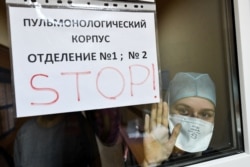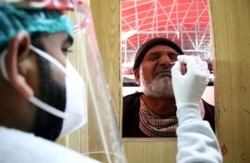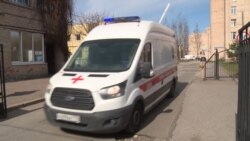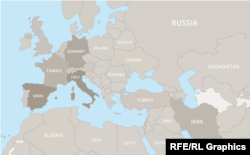MOSCOW -- When Anna Lopatina, a 41-year-old nurse at a hospital in Astrakhan, a city in southern Russia, fell ill in late March, she immediately took a test for COVID-19. It returned negative several days later, and Lopatina continued to go to work, living with her elderly parents, her sister, and her child. Then her fever returned.
A doctor came to her home and diagnosed Lopatina with flu. But her condition continued to worsen, and on April 10, she was delivered to the city's infectious-disease clinic with pneumonia. "I'm dying," she wrote in a text message to Maria Ledzhiyeva, a friend.
Struggling to breathe, Lopatina was connected to a ventilator. But doctors could not save her. An autopsy at a local morgue determined the cause of her death on April 14 as pneumonia. But Lopatina was buried like a carrier of the coronavirus, her coffin wrapped in plastic and interred by workers in protective overalls.
Because her initial coronavirus test returned negative, friends and relatives flocked to visit her family and pay respects. It wasn't until April 19, after another test, that the regional Health Ministry requalified Lopatina as the Astrakhan region's fourth confirmed coronavirus victim. By that time, both her elderly parents and her sister had been hospitalized with suspected COVID-19.
Lopatina's name was added this week to a running, unofficial tally of Russian medical workers who have died fighting the pandemic, a list updated daily by a group of doctors skeptical of government figures. The story of her deterioration and death, recounted by Ledzhiyeva to the Russian investigative outlet Proyekt, is typical of many that are helping fuel suspicions that Russia is wittingly or unwittingly underestimating its death toll from the pandemic -- which as of April 30 had sickened more than 106,000 people in the country and killed 1,073, according to the official count.
Accurate Numbers?
Government figures on mortality rates by country, compiled by Johns Hopkins University, indicate that Russia, at 0.9 percent, has by far the lowest case-fatality ratio from COVID-19 among the 10 countries with the highest number of confirmed infections. The figure for the United States, which has officially passed 1 million cases, is 5.8 percent. For Italy, it's 13.6 percent. In Germany, praised for its widespread testing and robust health-care system, the case-fatality ratio of 3.9 percent is more than four times that of Russia.
Russian Health Minister Mikhail Murashko praised the low death toll on April 22 and reported that the country's overall mortality rate in 2020 -- despite the pandemic -- had actually fallen year-on-year by 4.5 percent.
But critics point to official figures on cases of pneumonia, which is often caused by the coronavirus, as evidence that the confirmed COVID-19 death toll does not reflect reality. Moscow recorded 7,312 cases of pneumonia in February, 53 percent more than in February 2019; January saw a year-on-year increase of 37 percent. A Moscow deputy mayor, Anastasia Rakova, announced on April 27 that the number of patients hospitalized with pneumonia had risen 70 percent in the space of a week. "This cannot but provoke concern," she said.
When Anastasia Petrova, a 36-year-old journalist in the Urals city of Perm, died on March 31, health officials changed the official cause of death from double pneumonia to "double pneumonia brought on by coronavirus" only after a friend of Petrova's made public a text message in which Petrova revealed her second COVID-19 test had come back positive.
In Daghestan, in Russia’s North Caucasus, one doctor said on April 28 that at his hospital alone, 12 people had died of pneumonia in the previous four days: "80 to 90 percent [of those cases] are most certainly coronavirus," he said. But Daghestan as a whole had officially recorded only 11 COVID-19 deaths as of that date.
Due To Prompt Action?
Others defend the official tally, asserting that Russia's active testing regimen has resulted in a markedly lower case-fatality ratio. According to official statistics updated daily by the Russian government, almost 3.5 million tests for COVID-19 had been carried out as of April 30.
RFE/RL's Coronavirus Crisis Archive
Features and analysis, videos, and infographics explore how the COVID-19 pandemic is affecting the countries in our region.
"The more infections we uncover, the more the mortality rate declines proportionally," Yevgeny Timakov, a Russian infectious-disease specialist, said in a telephone interview.
Another argument cited in defense of the official numbers is that elements of Russia's response were implemented ahead of time. In January, Moscow restricted flights and closed its 4,000-kilometer border with China, and the following month it required people arriving from a growing list of countries to self-isolate for two weeks. With new cases rising slowly, Russia began imposing lockdowns later than many countries, starting on March 30 in Moscow, and shut all borders to most travellers the same day.
"Very early on, Russia was taking epidemiological measures and continues to do so," Melita Vujnovic, the World Health Organization's (WHO) representative in Russia, said in an interview. "There hasn't been an overwhelming of the health system, so quite a number of people can be treated." She added that Russia had "taken into consideration all the guidelines and all the recommendations given by the WHO."
WATCH: Trade, study, and tourism have ground to a halt between the Russian city of Blagoveshchensk and the Chinese city of Heihe since Russia closed the border amid coronavirus fears.
Suspicions about the death toll are driven in part by a lack of clarity over how and when deaths are classified as occurring from COVID-19. Confusion has reigned since the outset of Russia's epidemic, when the deaths of two Muscovites who were initially reported as victims of the new virus were subsequently chalked up by officials to other ailments. Russia reported its first death from the coronavirus on March 19, then quickly backtracked, saying the 79-year-old woman had died from a detached blood clot.
"The government is openly lying," Anastasia Vasilyeva, head of the Doctors’ Alliance labor union and a vocal critic of the Russian state's handling of health-care issues, told RFE/RL at the time.
A Changing Scale
Russia is not alone in facing accusations of inaccurate accounting. Because the attribution of death to COVID-19 depends on confirmation that the victim was a carrier of the virus, the lack of widespread testing undermines the reliability of death statistics across the world.
Analyses of official mortality figures around the world suggest the pandemic may be responsible for "all-cause excess mortality" indicative of a global death toll from the virus far higher than official numbers show. "All-cause excess mortality" is the figure for deaths above the long-term average, and is widely seen as the most reliable gauge for measuring the costs from a pandemic.
Some countries, like Italy and the United States, include in their official tally of COVID deaths all deceased patients in whom the virus has been detected, regardless of whether it was the proximate cause of death, Inna Danilova, a Russian demographer, told RFE/RL's Russian Service. Russia does not do that.
WATCH: Scheduled surgeries for patients in Russia are being canceled as resources are diverted to fight the COVID-19 epidemic. Treatments are being delayed or denied for patients with conditions like cancer, hepatitis and cystic fibrosis.
So far, there is no universal system for ascertaining mortality rates from the virus. In Russia, the common practice is to collect statistics and release them as part of an annual report with the final, underlying cause of death cited. But the current situation calls for a running tally of deaths. In Britain and Belgium, for instance, officials began collecting daily numbers of deaths from hospitals, and stood accused of overlooking deaths in care homes. In Italy and Spain, many deceased people were tested for COVID-19, with positive diagnoses added to the death record.
On April 16, the WHO published new guidelines on "coding" mortality during the pandemic -- confirming and classifying COVID-19 as the cause of death, part of an effort to institute a more uniform standard across the world as the pandemic continues to take lives.
"Coding of deaths is not a straightforward process," Vujnovic said. "In any country, the death certificate includes the immediate and underlying cause of death." She said that Russia had been receptive to the new guidelines and was translating them for use by doctors across the country.
But some Russian experts argue that the new guidelines are a case of too little too late. "The instruction is rather vague," Vladimir Shkolnikov, a demographer at Moscow's Higher School of Economics, told RFE/RL's Russian Service. "What the WHO is proposing now contradicts the usual method of ascertaining cause of death."
Shkolnikov, a co-author of a new paper in The Lancet medical journal that argues for weekly reports on excess mortality, said WHO guidelines that COVID-19 should be listed as the cause of death even if it is accompanied by another underlying condition that contributed to the fatal outcome may be misleading.
Live Map: The Spread Of The Coronavirus
He cited flu epidemics that affected Russia in 2015 and 2018 and caused a spike in mortality rates of 12 to 17 percent. "We see in that data higher-than-expected all-cause excess mortality," he said. "But if we look at deaths specifically from flu or pneumonia, we see very small numbers not comparable to that overall spike. Why? Because among those who die of the flu, there's a large number of elderly people who suffer from cardiac or respiratory problems, cancer, and other chronic illnesses, without which it's unlikely that so many of them would die during a flu epidemic."
So in many cases, he said, doctors listed the causes of death in 2015 and 2018 not as flu but as "death from serious underlying illness" that was exacerbated by the flu. The same tendency not to record coronavirus as the cause of death may be impacting official statistics in Russia as the country battles the latest epidemic.
"With what we know about the disease, we know the deaths can come from the third day to three weeks later. So we have to monitor in the coming weeks to be able to say for sure what the exact situation is," Vujnovic said. "We are expecting more deaths, but that will come proportionally with the rise in cases and the length of the pandemic."
Struggling To Cope
The unofficial tally of Russian medical workers stricken by the pandemic now lists 74 names. The number had always exceeded the official figure provided by the authorities, but on April 29, Health Ministry epidemiologist Nikolai Briko cited the medics' list in a statement lamenting "multiple clusters of coronavirus infection first and foremost in medical organizations."
In a televised conference with officials on April 28, President Vladimir Putin issued his most somber assessment to date of the country's battle with the coronavirus.
"We are facing a new and perhaps the most intense stage in countering the epidemic," he said. "The risk of infection is reaching its peak, and the threat and the mortal danger of the virus remain."
If Putin's prediction proves true, Russia may be facing the toughest challenge in its effort to fight the coronavirus and keep the death toll down -- at a time when its hospitals are already stretched to capacity.
"So far, the health-care system has reacted adequately," said Timakov, the infectious-disease specialist. "But no health-care system in the world can handle a huge spike in infections."




















